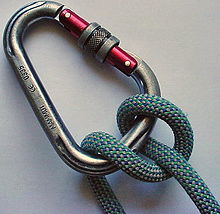| Munter hitch | |
|---|---|
 | |
| Names | Munter hitch, HMS, Italian hitch, Flip-Flop knot, Crossing hitch (ABoK #1818, #1725, #1797) |
| Category | Hitch |
| Related | Half hitch, Zigzag Knot (ABoK #1195), Monster Munter |
| Releasing | Non-jamming |
| Typical use | Belaying |
| Caveat | Wears out the rope when used for descending |
The Munter hitch, also known as the Italian hitch, mezzo barcaiolo or the crossing hitch,[1] is a simple adjustable knot, commonly used by climbers, cavers, and rescuers to control friction in a life-lining or belay system. To climbers, this hitch is also known as HMS, the abbreviation for the German term Halbmastwurfsicherung, meaning half clove hitch belay. This technique can be used with a special "pear-shaped" HMS locking carabiner, or any locking carabiner wide enough to take two turns of the rope.
In the late 1950s, three Italian climbers, Mario Bisaccia, Franco Garda and Pietro Gilardoni developed a new belay technique called the "Mezzo Barcaiolo (MB) meaning; "a half of the knot, which is used by the sailors to secure a boat to a bollard in a harbor."[2] The "MB" came to be known as the Munter hitch after Werner Munter, a Swiss mountain guide popularized its use in mountaineering in the 1970s.[3] This hitch was studied and then promoted for its use in the mountains (being officially recognized by the UIAA towards the end of the sixties), by the Italian Alpine Club and, in particular, by its Central Commission for Materials and Techniques.[4]
The hitch is simply a set of wraps using a rope or cord around an object, generally a round object like a pipe, pole or more commonly, a carabiner. Its main use is as a friction device for controlling the rate of descent in belay systems.
- ^ Clifford W. Ashley. The Ashley Book of Knots. Doubleday, 1944. p. 306.
- ^ Phillips, Ken. "NPS Technical Rescue Handbook" (PDF). Mountain Rescue Association. National Park Service. Retrieved 4 March 2021.
- ^ George, Caroline. "Munter Magic". Climbing Magazine. Retrieved 2019-04-14.
- ^ "Cai Materiali". CAI Materiali. Retrieved 4 March 2021.